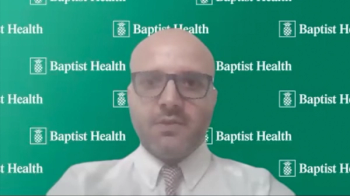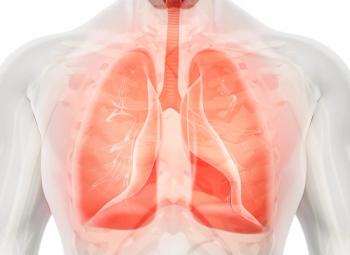
DART Yields Robust Survival Benefit vs Standard of Care in HPV-Associated Oropharyngeal Squamous Cell Carcinoma
Patients with human papillomavirus–associated oropharyngeal squamous cell carcinoma experienced good quality of life and promising survival benefit after being treated with de-escalated adjuvant radiation therapy.
Treatment with de-escalated adjuvant radiation therapy (DART) resulted in robust responses in a population of patients with human papillomavirus–associated oropharyngeal squamous cell carcinoma compared with standard of care adjuvant treatment, according to findings from the phase 3 MC1675 trial (NCT02908477) presented at the
Patients treated in the standard-of-care arm experienced a 2-year overall survival (OS) rate of 97.0% (95% CI, 91.3%-100%) versus 96.1% (95% CI, 92.3%-100%) in the DART arm. In patients who were ENE–negative disease, the 2-year OS rates were 90.9% (95% CI, 75.4%-100%) and 100% (95% CI, 100%-100%) in the standard of care and DART arms, respectively. Conversely, patients with ENE-positive disease experienced corresponding OS rates of 100% (95% CI, 100%-100%) and 93.4% (95% CI, 87.3%-100%).
“DART demonstrated less toxicity, improved swallowing function, and quality of life [QoL] compared with standard of care. DART also [resulted in] excellent locoregional control, progression-free survival [PFS], and OS rates, particularly in the ENE-negative cohort,” according to lead author Daniel Ma, MD, a head and neck radiation oncologist in the Department of Radiation Oncology at Mayo Clinic in Rochester, Minnesota. “Our future work will define risk groups that may not [respond to] adjuvant care, ones that may require DART, and ones that require full systemic treatment or possibly even systemic intensification.”
Investigators enrolled 194 patients with p16-positive oropharyngeal squamous cell carcinoma whose disease was resectable by transoral robotic surgery (TORS). Patients with T3N2 disease or higher and either lymphovascular or perineural invasion were stratified to cohort A (n = 79) and those with ENE-positivity were stratified to cohort B (n = 115). Patients in cohort A were either treated with 30 Gy of radiation, including 1.5 Gy twice a day for days 1 to 5 and 8 to 12 plus 15 mg/m2 docetaxel on days 1 and 8 (n = 53) or 60 Gy in 2 Gy fractions (n = 26). Patients in cohort B received either 36 Gy of radiation, including 1.8 Gy twice daily on days 1 to 5 and 8 to 12 plus 15 mg/m2 of docetaxel on days 1 and 8 (n = 77), or 60 Gy in 2 Gy fractions plus 40 mg/m2 of cisplatin weekly (n = 38).
The study’s primary end point was rate of adverse effects (AEs) of grade 3 or higher 3 months or more following radiotherapy, with key secondary end points including OS, local/regional control (LRC), and PFS.
Patients had a median age of 59.4 years, and the majority were male (89%) and non-smokers (72%). The study had a median follow-up of 25.3 months.
Additional findings from the study indicated that patients in the standard-of-care and DART arms experienced 2-year locoregional recurrence–free survival (LRFS) rates of 97.9% and 95.5%, respectively. Patients in the standard of care arm had a 2-year PFS rate of 95.1% compared with 86.5% in the DART arm.
Among patients with pN2 disease, those in the standard-of-care and DART arms had 30-month PFS rates of 100% and 42.9%, respectively. Patients in both groups had a distant metastasis–free survival rate of 100% and 59.4%, respectively. Similarly, those in the standard-of-care arm had an LRC rate of 100% versus 77.0% in the DART arm.
Moreover, in terms of locoregional control, patients with ENE-negative disease who received standard of care had a 2-year LRFS rate of 93.3% compared with 100% in the DART arm. Patients with ENE-positivity experienced LRFS rates of 100% and 92.2% in each treatment arm, respectively.
Investigators did not report any grade 5 post-operative AEs. The post-operative TORS interventional bleed rate was 3.2%. A total of 1.6% of patients in the DART arm and 27.4% of patients in the standard-of-care arm (P <.0001) required the use of a feeding tube. Investigators also reported that 1.6% of patients in the DART arm and 7.1% of patients in the standard of care arm (P = .058) experienced AEs of grade 3 or higher 3 months following treatment.
It was also noted that swallowing function following radiotherapy was superior in those who received DART (Modified Barium Swallow Impairment Profile, -0.3 vs -2.6; P = .0155). Moreover, patients treated with DART had a better QOL, less pain, and less xerostomia compared with the standard of care arm.
Reference
Ma DJ, Price K, Moore EJ, et al. MC1675, a phase III evaluation of de-escalated adjuvant radiation therapy (DART) vs. standard adjuvant treatment for human papillomavirus associated oropharyngeal squamous cell carcinoma. Int J Radia Oncol Biol Phys. 2021;111(3):S61. doi:10.1016/j.ijrobp.2021.07.155
Newsletter
Stay up to date on recent advances in the multidisciplinary approach to cancer.



















































































